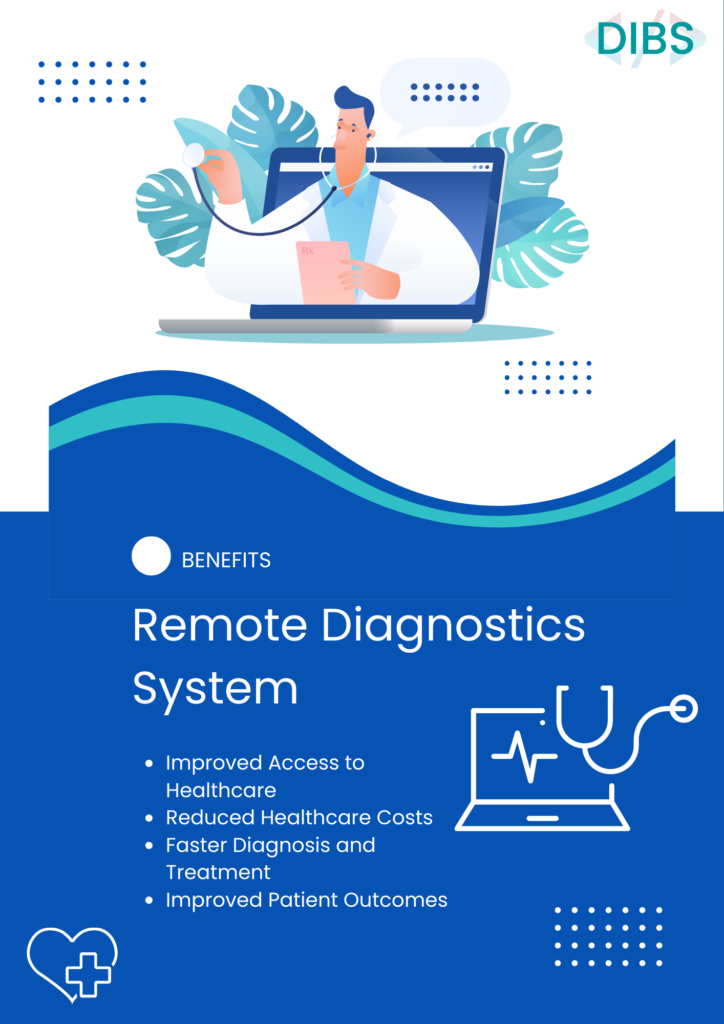In the ever-evolving landscape of technology, the healthcare industry stands at the forefront of innovation. Among the groundbreaking advancements within this field is the Remote Diagnostics System. In this blog post, we will dive deep into the realm of the remote diagnostic system, uncovering the potential it holds for companies seeking to develop applications that could revolutionize the healthcare landscape. We will explore the opportunities presented by this transformative technology.
Remote diagnostics systems are a type of telemedicine technology that enables healthcare providers to remotely diagnose. It also allows them to treat patients using digital tools and technologies. These systems have become increasingly important in recent years, especially in the wake of the COVID-19 pandemic, which has highlighted the need for remote healthcare services.
Remote diagnostics systems use a range of technologies to enable healthcare providers to diagnose and treat patients remotely. These technologies include video conferencing, remote monitoring devices, and diagnostic tools that can be used remotely. The system can be used to diagnose a range of conditions, from chronic conditions such as diabetes and heart disease to acute conditions such as infections and injuries.
The Changing Landscape of Healthcare
Traditionally, healthcare services have often been associated with in-person visits to medical facilities. However, the advent of remote diagnostic systems has brought about a significant shift in this paradigm. These systems allow patients to monitor their health, receive real-time feedback, and even consult healthcare professionals without leaving the comfort of their homes. This transformation is particularly relevant to wellness centres and diabetic speciality hospitals. It empowers them to provide better care and convenience to their patients.
Remote Diagnostics System vs. Mobile Patient Monitoring:
Remote diagnostics and mobile patient monitoring are both healthcare technologies that leverage digital tools to improve patient care and healthcare delivery. But, they serve different purposes and have distinct characteristics. Here’s how they differ:
- Remote Diagnostics: A remote diagnostic system primarily focuses on the process of diagnosing a medical condition or assessing a patient’s health status from a distance. It often involves the use of medical devices and technology to gather data. It then provides insights to healthcare professionals for making diagnoses and treatment decisions. Remote diagnostics can be especially useful in situations where a quick and accurate diagnosis is essential, such as in emergencies or when patients are located far from healthcare facilities.
- Mobile Patient Monitoring: Mobile patient monitoring is more focused on continuous tracking and management of a patient’s health over time. It involves the collection of health data, such as vital signs (e.g., heart rate, blood pressure, oxygen levels), activity levels, and symptoms, using mobile or wearable devices. This data is then transmitted to healthcare providers for ongoing assessment and intervention. Mobile patient monitoring is often used for managing chronic conditions, post-surgery recovery, and long-term health maintenance.
Benefits of Remote Diagnostics System:
- Enhanced Patient Engagement: Wellness centres and diabetic speciality hospitals can now engage their patients more effectively. Remote monitoring devices and apps keep patients connected to their healthcare providers. It leads to better adherence to treatment plans and improved overall health outcomes. A wellness centre provides fitness trackers and an app for clients. Real-time data tracking fosters client engagement, leading to better adherence to fitness and nutrition plans and improved health outcomes.
- Timely Intervention: Remote Diagnostics Systems enable healthcare professionals to detect health issues in their early stages. For diabetic speciality hospitals, this means catching complications before they become severe. Early intervention can significantly improve patient outcomes. A Remote Diagnostics System alerts a wellness centre to a client’s elevated heart rate during a virtual session, prompting quick medical attention and preventing potential complications.
- Streamlined Workflow: These systems simplify the workflow for healthcare providers, allowing them to prioritize patients who need immediate attention. This ensures that patients with critical conditions receive prompt care while others can continue their routine monitoring. Healthcare providers at a diabetic speciality hospital use a dashboard to identify patients with consistently high blood glucose levels, allowing them to prioritize care efficiently.
- Cost-Efficiency: Implementing a remote diagnostic system can reduce the burden of in-person visits and hospitalizations. It can result in potentially lowering costs for both patients and healthcare facilities. This is especially valuable for wellness centres looking to offer affordable services. A diabetic speciality hospital’s Remote Diagnostics System reduces in-person visits, lowering patient transportation costs and administrative overhead while providing affordable care and convenience.

Features of Remote Diagnostics System:
- Data Collection and Monitoring: The system collects and analyzes various health-related data, including vital signs, symptoms, and medication adherence, from connected devices such as wearables, sensors, and smartphones.
- Real-Time Alerts: It provides real-time alerts and notifications to both patients and healthcare providers when critical health parameters fall out of the normal range. It allows for immediate intervention.
- Secure Data Transmission: Ensures the secure and encrypted transmission of patient data from devices to healthcare facilities, complying with data protection regulations like HIPAA and GDPR.
- Telehealth Integration: Allows for virtual consultations and remote healthcare services. It enables patients to communicate with healthcare professionals through video calls, chat, or voice.
- Electronic Health Records (EHR) Integration: Integrates with EHR systems, enabling healthcare providers to access a patient’s complete medical history and make informed decisions.
- Medication Management: Helps patients manage their medications by sending reminders for dosages and refills and tracking medication adherence.
Challenges of Remote Diagnostics System:
- Data Security and Privacy Concerns: Patient health data is highly sensitive, and any breach can lead to severe consequences. Ensuring robust data security measures and adherence to privacy regulations is crucial.
- Interoperability Issues: The integration of various medical devices and software platforms within the system may be complex. It could lead to data inconsistencies and inefficiencies. If a patient’s blood pressure monitor cannot seamlessly transmit data to the Remote Diagnostics app. It is due to compatibility issues, causing data gaps.
- Reliability of Connectivity: In regions with poor internet connectivity, data transmission delays or failures can impede the system’s ability to provide timely updates and interventions. If a patient living in a rural area experiences frequent internet outages, preventing the timely transmission of their vital signs to the healthcare provider.
- Data Accuracy and Quality: Inaccurate or incomplete data from connected devices can lead to incorrect diagnoses and treatment decisions. A fitness tracker worn by a patient provides erratic heart rate readings. It could be leading the system to send false alarms of a potential cardiac issue.
- User Adoption and Engagement: Patients may resist using the system due to a lack of technical proficiency, concerns about data security, or discomfort with remote monitoring. An elderly patient with limited technology experience hesitates to use the Remote Diagnostics app, resulting in underutilization of the system.
- Regulatory Compliance: Failing to adhere to healthcare regulations and standards can result in legal and financial penalties. A healthcare provider inadvertently shares patient data with a third party without obtaining proper consent, leading to regulatory fines.
The Future of Healthcare Is Here
Remote Diagnostics Systems are reshaping the healthcare landscape, offering incredible opportunities for businesses like wellness centres and diabetic speciality hospitals. These systems not only enhance patient care but also streamline operations and reduce costs. By embracing this technology and developing your own Remote Diagnostics app, you can position your business at the forefront of healthcare innovation. It can also provide your patients with the care and convenience they deserve. The future of healthcare is here, and it’s time to be a part of it.
In conclusion, remote diagnostic systems are an essential tool for healthcare providers. The system provides a range of benefits. It includes improved access to healthcare, reduced healthcare costs, faster diagnosis and treatment, and improved patient outcomes. Healthcare providers should invest in a robust and customizable remote diagnostics system to improve their patient care and expand their reach to remote or underserved areas.
Talk to our experts and find out more about the latest healthcare technologies and how DIBS team can help to remotely monitor and diagnose patients, leading to improved access to care, reduced healthcare costs, and enhanced patient outcomes.







Leave a Comment